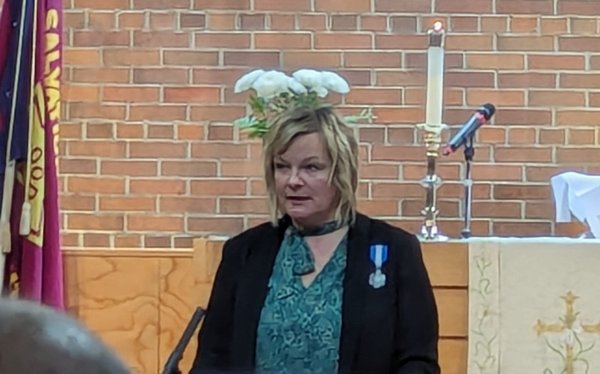That book title (Hoover Institution Press, 1986) refers to the century-old question plaguing American foreign policy: “Can the Soviets be trusted?” The same question should be asked about today’s Russia.
The author, Loy Henderson, was the only American foreign service officer who answered with a resounding “NO!” throughout his life, while others wavered. This is the story of one of the greatest Second World War and Cold War American diplomats. Especially from the Baltic point of view.
The author was the man considered to be the creator of basic American policies toward the Soviet Union and the teacher of those whose names are better known today, like Chip Bohlen and George Kennan.
I can say I was honored to shake his hand a couple of years before his passing when he and his wife were guests at the Estonian Independence Day ceremonies at the Baltimore Estonian House.
Loy Wesley Henderson was the original author of the Non-Recognition Declaration. He was born in Rogers, Arkansas in 1892 and died in Bethesda, Maryland in 1986. Mr. Henderson began his public service in the Baltic area in 1919 as a member of the Inter-Allied Commission to Germany for repatriation of prisoners of war and as a member of the American Red Cross Commission to Europe. According to his memoir, his biggest – and most successful - task was the anti-typhus campaign in Estonia, especially in the Narva area. The superhuman effort included trying to stop the spread of the disease originating in Russia. It almost claimed his life.
His life was further cemented to the Baltics when he married Elise Marie Heinrichson of Latvia in 1930 while posted as the Third Secretary at the Legation to the Baltic States in Riga. He spent eighteen of his State Department career years in the East European area.
There is ample evidence that he had private ties to the Baltic diplomats in Washington and frequently consulted with the Latvian Ambassador at the time of the Soviet occupation of the Baltic States.
In the book as well as in an Oral History interview, Henderson said his service in the Baltic States, the Soviet Union and Germany, from the very beginning, enabled him “to learn a great deal about that part of the world and about Soviet attitudes and policies.” He said that “in Germany, [he] saw the efforts of the Communists under Soviet guidance: Great mobs of Communists or communist sympathizers would go into the streets and sometimes for hours pillage, kill and burn. In Germany and the Baltic States the Communists were looking for weaknesses with which to make trouble, to weaken the governments in power.” He said that when he opened the American Red Cross office in Kaunas, “the Communists did their best to interfere with our work. They even fired at staff members and a bullet hit the door a few inches from my head.”
Henderson urged greater Red Cross help to the Baltics “because such aid might help them to combat Communist aggression.” He said the three countries welcomed it. He stressed that even by 1919 he had formed opinions about the Communists and their activities.
In 1927, the State Department considered Riga to be “the most important source of information on the Soviet Union.” Henderson, when posted there, said that the Riga legation was the only agency of the U.S. Government “in a position to expose for the benefit of the Department the exaggerated nature of Soviet claims of accomplishments.” The main task of the legation was to try to bring more clearly into focus what it considered to be the true picture of the situation in the Soviet Union. The Department staff said this was necessary because it was not only combating Soviet propaganda, but misguided reports by Western journalists.
Recognition
Henderson said that the United States should not deal with a state if it could not be trusted to live up to its agreements and added: “It was my belief that since the leaders of the Kremlin eventually were intending to contribute to the violent overthrow of all the countries with which the Soviet Union maintained relations, they considered Soviet relations with every country to be of a temporary or transitional character, subject to change at any moment.”
As the Franklin D. Roosevelt administration came to power, it became clear that its aim was to recognize the Soviet regime, even if it did not adhere to the basic principles of international conduct. Henderson was upset. He noted that this was no longer the America of Wilson, Harding, Coolidge and Hoover. According to the old principles, either the Soviet government had to adhere to the accepted rules of international conduct, or it would not. If it did adhere to the rules, then it could join the international community; if it didn’t, then not.
In early 1930, the State department professionals, especially in the East European Department, were flatly against diplomatic recognition of the Soviet Union. They said that until it was clear that the USSR was trustworthy, there was no point, only danger, in establishing a formal connection. According to Henderson, the professionals were appalled when recognition was extended in 1933. He was irritated at having to deal with the confusion that followed recognition.
By 1935, it seemed clear to the foreign service that the recognition was a mistake. The U.S. Ambassador to Moscow, William C. Bullitt, left his post in disillusionment. His replacement in 1937, Joseph E. Davies, indicated a major change. Davies was full of enthusiasm and believed, like Roosevelt, in the power of personal persuasion. Incredibly, with both Davies and Henderson in Moscow at the same time, even while Davies was optimistic, Henderson sent somber dispatches to Washington. But it didn’t really matter, as Roosevelt took personal charge of U.S. foreign policy and distrusted State Department experts.
Confusion ensued. Henderson and the State Department continued to warn against trusting the Soviets. The picture was complicated by the isolationist and generally anti-Soviet mood of the U.S. public, the refusal of the Soviets to cooperate on issues such as the unsettled debt and communist agitation in America. Soviet Foreign Minister and later Ambassador to Washington, Maxim Litvinov, had made a promise to stop the communist agitation as a condition of recognition. Reneging of that promise upset Washington, including in this case, the President himself. At the same time, the Soviets took advantage of a friendly but naïve White House, all of which contributed to secrecy over all matters Soviet and gave rise to countless Soviet agents, spies and fellow travelers flooding Washington.
However, Henderson did not abandon his basic beliefs gained from long experience in the Baltics and Moscow. Long before Kennan’s famed “Long Telegram,” Henderson, upon leaving Moscow in 1938, wrote a paper on Soviet policies. Historian George Baer, who wrote the introduction to Henderson’s memoir, listed Henderson’s main points:
1. The unreliability of a U.S. alliance with Moscow;
2. Russia’s intentions and cooperation were entirely tactical and contrary to America’s interests;
3. Russia’s long-term goals were, flatly: military buildup, territorial expansion, and control of Europe and world revolution.
Henderson’s anti-Soviet stance cost him dearly. To this day, other diplomats have called him “a hard liner,” an “anti-Soviet crusader” and worse. It is interesting to note some moves behind-the-scenes. During the war, Maxim Litvinov commented that U.S.-Soviet relations would not improve until Henderson is removed from the East European area. He conveyed that to his friend, Eleanor Roosevelt, who in turn practically ordered Sumner Welles to get rid of Henderson. Secretary of State Cordell Hull resisted, but continued pressure from the White House forced Hull to reassign Henderson out of area.
The Declaration
A sharp turn in Roosevelt’s thinking came with the Molotov-Ribbentrop Pact in August 1939. It also confused Henderson, but only temporarily. Within weeks, he commented that the Pact appeared to be only a short-run expedient. It did not change his basic view, as expressed in a memorandum written a month before the Pact: “The present rulers of Russia are still dominated by a spirit of aggressiveness, that is, they have not departed from the ultimate aim to enlarge the Soviet Union and to include under the Soviet system additional peoples and territories.”
The book ends with the beginning of the war September 1, 1939, when Hitler invaded Poland. However, interviews made with Henderson in the 1980s indicate that both Roosevelt and Henderson took a cautious attitude despite the invasion of Poland and the Baltic States. Historian George Baer says the U.S. did not want to alienate Stalin at a time when West European states were under heavy Nazi threat, fearing that Stalin would seek a further accommodation with Hitler. At the same time, the Roosevelt Administration felt it could not signal approval of Stalin’s conquests.
Henderson said Roosevelt’s views about the Soviet Union “seemed to vary from time to time.” Despite Roosevelt’s desire to be friendly toward Moscow, the Soviets were “almost contemptuous of him and his feelings.” Henderson said Roosevelt got angry when he saw that “his charming personality and his ability to persuade” did not work.
At that point, Henderson said Roosevelt became “indignant about the Soviet annexation of the Baltic States.” So in the early morning of July 23, 1940 Acting Secretary of State Sumner Welles asked Henderson “to prepare a statement for issuance to the press expressing sympathy for the people of the Baltic States and condemnation of the Soviet action.” Upon receiving the draft, Welles said it was not strong enough and in Henderson’s presence, called Roosevelt. Several sentences were recast and Welles then sent it to the press room for issuance without further consultation. As the statement was issued over Welles’ signature, Henderson explained that Roosevelt almost never signed “unpleasant exchanges with the Soviet Union.”
There was one exception. As the American people were especially shocked at Soviet attack on Finland in November 1940, Roosevelt personally issued statements critical of the Soviet action, even telling a group of students that Moscow was the aggressor. This upset Eleanor Roosevelt, who tried to persuade the President that Finland was really the aggressor. In this, the State Department prevailed.
Henderson spent more than a year “in exile” in British-controlled Iraq, but was called back to Washington in the spring of 1945. Under the Truman Administration, as Under Secretary of State Dean Acheson’s top aide, Henderson was instrumental in carving out the early Cold War policies. Professor Baer said in sum: “From these labors came the Truman Doctrine and the Marshall Plan and a radically new U.S. foreign policy. Containment, opposition to Soviet political and territorial expansion, efforts to keep Europe and Turkey out of the Soviet orbit – these policies flowed from the conclusions about U.S.-Soviet relations that Henderson and his colleagues had long held. To Henderson, the Cold War came as no surprise.”
One notes, though, that the above quote talks rather erroneously about “efforts to keep Europe and Turkey out of the Soviet orbit…” It would be more accurate to say Western Europe, as this was the intent of Roosevelt and Churchill all along. Eastern Europe (to include the Baltic States), history shows, was never of any interest to Roosevelt except as a Soviet orbit. In Great Britain, Anthony Eden’s pro-Soviet stance pressured a somewhat reluctant Churchill into going along with Roosevelt.
Nevertheless, Loy Henderson was the voice of truth in the Washington wilderness and did what he could. He deserves a lot of credit.
VELLO EDERMA
May 16, 2008
A question of trust (12)
Archived Articles | 30 May 2008 | EWR
Viimased kommentaarid
Kommentaarid on kirjutatud EWR lugejate poolt. Nende sisu ei pruugi ühtida EWR toimetuse seisukohtadega.
Brett, for one thing, no one even remembers Yakovlev making a dint of any kind during cold war politics remotely equal to that of Dobrynin. The latter was the main player most US politicians sucked up to in a big way. Yakovlev came onto the scene in the second half of the 1980's, and as you say, never really left held great sway in politics per se. It wasn't until the Petersburg mob, including the likes of Sobchak, made a breakthrough in new thinking (which is NEP policy in new dress) that anyone bothered to take notice of Yakovlev. Sorry to put you straight, but you are considerably off the mark with your theory.
Maxim agrees with himself.
Thats not an easy thing to do when your confused, and only want to rile the v"alis eestlased
Thats not an easy thing to do when your confused, and only want to rile the v"alis eestlased
Made spelling errors above - Yakovlev.
Archived Articles
TRENDING




















